A more impressive collection of American veteran cars than that of the Norwegian machine contractor Ole Martin Manvik, is hard to find.
By: Runar F. Daler/Anleggsmaskinen, translated by Tone Anderssen
Ole Martin Manvik (59) emerges as a typical machine contractor; chatty, pleasant, down to earth, with a hand-rolled cigarette between his fingers. When we arrive at his farm on the outskirts of Larvik, a small town in the south of Norway, we sense that we are dealing with an unusual person. And when he pushes us into his old potato cellar, we realize that we are about to see something quite unique.
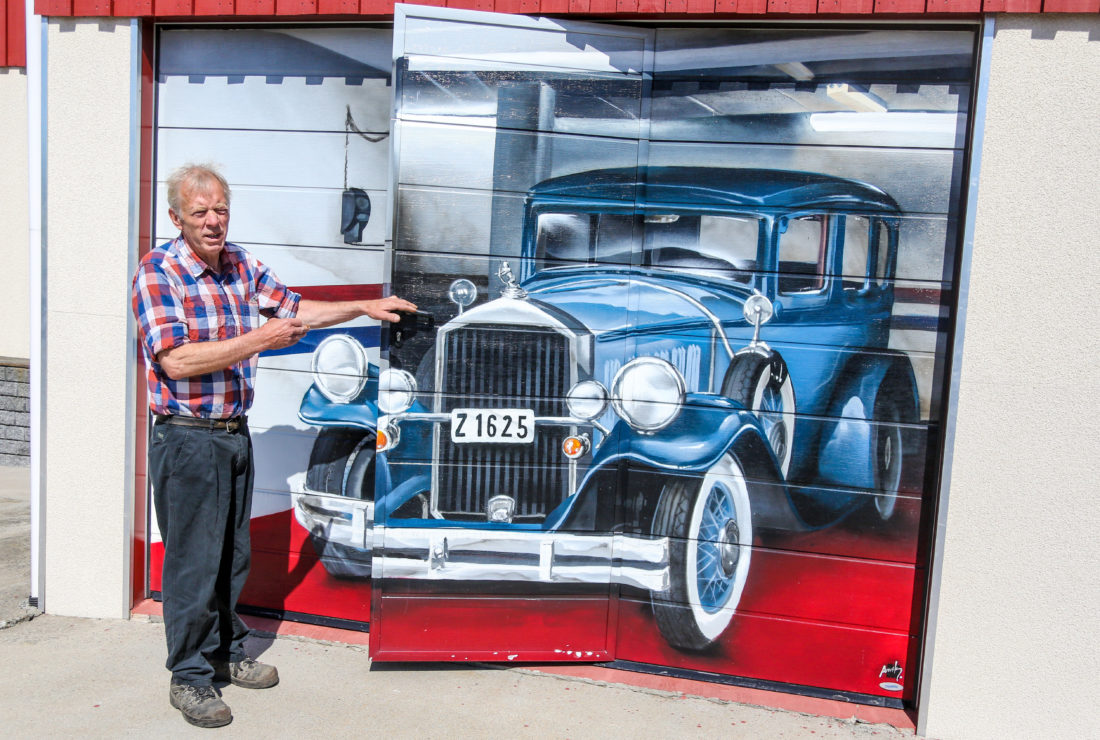
HIS OWN STATUE OF LIBERTY
Manvik’s farm is exceptionally well kept, with buildings in perfect condition, flawless lawns and hedges straight as arrows, but as we move further in between the barns, we are filled with wonder: There, on a neat low wall of stone we are faced with a 15 feet tall copy of the famous American Statue of Liberty!
The cellar door on the adjacent building is decorated with a beautiful painting revealing the treasures behind it. It depicts an old American car, a Pierce Arrow, resembling the vehicles in the old mafia movies. When Manvik opens the door to what used to be a potato cellar, a series of old veteran cars appear – all of them in excellent condition.
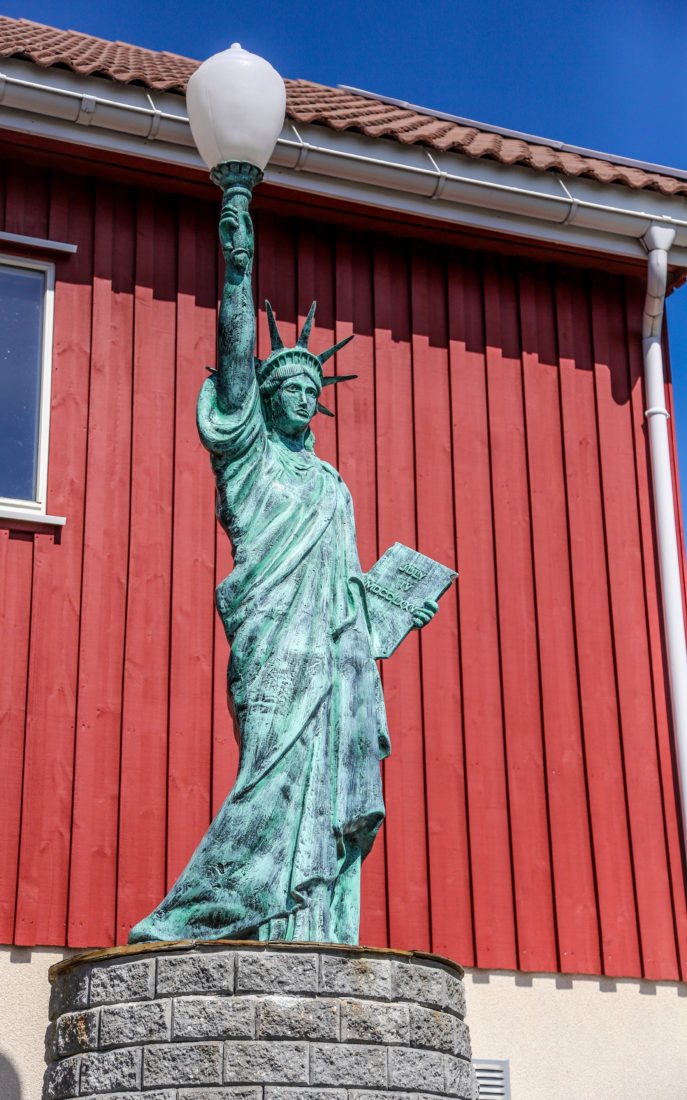
IMPRESSIVE
The first automobile we approach is a T-Ford (1914 model), which the Norwegian TV audience recently admired in a popular reality show, “The Farm”, with Manvik as its chauffeur. We move past several T-Fords, two Pierce Arrows, one White 1924 model and an Overland (1912 model) – a former driving school vehicle which has also been used as a taxi in the Norwegian capital, Oslo. Behind them, we discover a Studebaker (1925 model) and another Pierce Arrow (1929), plus yet another Pierce Arrow (1927 model) and the “jewel in the crown”, an Ahrens Fox fire truck (1930) which was in use in Texas in the thirties. It is, to put it mildly, an impressive collection.
“When counting restored vehicles and ongoing projects, I have 17 or 18 models here today. Restoring a car for a museum is one thing; quite another matter is restoring cars for use. More or less all these cars are in drivable condition. Actually, it is vital that they are taken out for a drive every now and then, or else they may “die standing”,” Manvik explains.
“Many of these cars are popular for weddings, school proms, and so on. They have also been used to add prestige to various events, such as opening of a new bridge. I also lend them out to bachelorette parties … I prefer ladies, you see, as they are more careful…
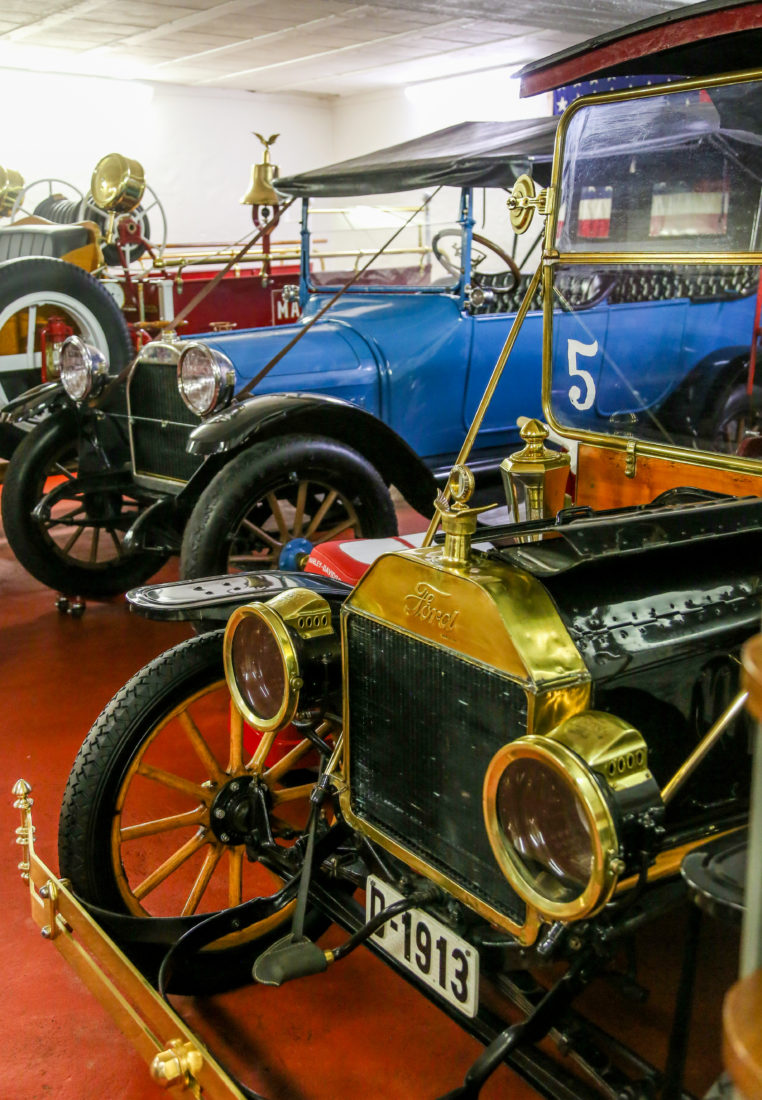
BOUGHT A FIRE TRUCK IN INDIANA
“Regular black T-Fords are practically off-the-shelf items nowadays, while the brass kinds are rare. All T- Fords parts, as well as Studebaker parts, are easily bought on the Internet and transported to your door in a couple of workdays. Not so for the Pierce Arrow, or the Ahrens Fox for that matter. These parts are hard to find, and even impossible to find outside of the USA”, Manvik explains.
“In the 1920s, the price of a Pierce Arrow was 7000 dollars, while a T-Ford was 300 dollars. So you could get 20 – 30 T-Fords for the price of one Pierce Arrow! After the 1929 stock market crash, however, everything was practically worthless. People couldn’t pay, and the cars were seized by the authorities and rebuilt as fire trucks, ambulances, hearses, etc. This Pierce model was originally a 7-seat passenger car, before the authorities rebuilt it as a fire truck. I bought it from retired fire fighters in Indiana,” Manvik tells us, pointing out the exceptional truck in the corner of his potato cellar.
NO SCHOOL WIZARD, BUT “A” IN WOODWORKING CLASS
Ole Martin Manvik was born and raised on this farm on the southern coast of Norway, which he inherited from his parents in 1999. He was never a school wizard, but – like so many construction workers – he was a practical boy.
“I wasn’t really into theoretical subjects. When you have to learn something that you find useless and uninteresting, it just does not stick. But I liked the practical and physical subjects – where you get visible, concrete results,” he tells us.
“I may have been somewhat ill-mannered at school, and I guess I played hooky now and then. I did get one A – in woodworking – but the rest of my report card is best forgotten. I never even picked it up, to be honest. Except for my woodwork teacher, I didn’t get along with any of my teachers. They gave up on me, I guess. But as an adult I have established a great relationship with quite a few of them, which I find kind of amusing.”

The vehicle is fully restored, down to the smallest screw. Manvik drove it in the local Independence Day procession. (Photo: Runar F. Daler).
EARLY PRACTICE…
Manvik was introduced to construction work at an early age. His father did the digging for the local power plant, so before he turned 15 he was doing cable work and clearing land for power lines.
“At the age of 18 I was registered as self-employed, and my first assigned jobs were for the municipal power plant. I was pricing power lines, I followed the staking out, I cleared land for the lines, got the poles, put them in the ground and raised them – the whole process. I quickly established a good relationship with the head of the power plant, and he eventually called the local sheriff to tell him that I needed a blasting certificate. Back in those days, if you were pal with the local sheriff and the head of a power plant, most things worked out,” he laughs.
STARTED WITH A DIGGER – “BROYT”
Eventually, Manvik left the local power plant and started working with blasting operation and rock securing. He bought a digger, Broyt X2B, which he used for the blasting operations. He employed four people, but after the recession in the late 80s, he had to cut down. At present, he has two men available for hire when needed.
“I have never called in sick. But in the late 90s I had a reaction to working with wet dynamite and wet gloves over a long period. The nitro-glycerine made me sick, gave me a terrible headache. I have never been so sick in my life; that evening I almost thought my hour had come… So I phased out the blasting work, but kept going with the rock securing. However, I am nearing my sixties…, even though my head works, my body will not hang from a rope, rappelling down steep mountains, anymore. So, nowadays I work with water pipes and sewers, I dig out building sites and do all kinds of groundwork, mostly for private customers and sometimes for the municipality.”
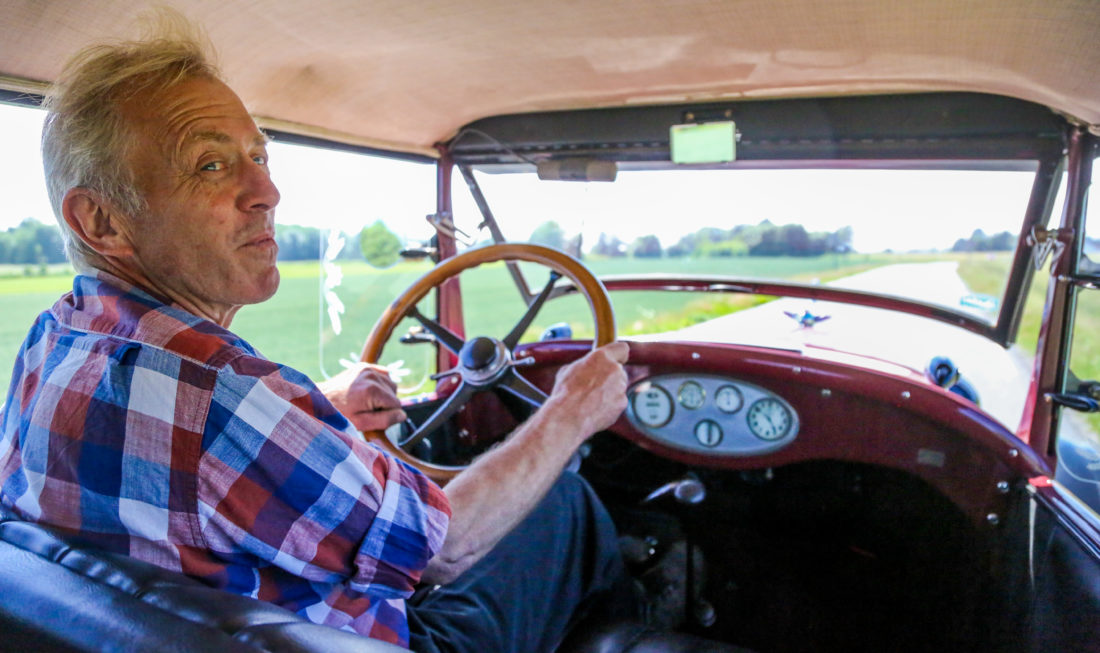
LIBERAL POLITICIAN
In 1991, Manvik entered the political scene, almost by accident. He is still active in the right-wing “Progress Party”, as a board member of the greater county party.
“I never studied the party program, nor did I consciously decide to go into politics. I was more or less tricked into letting them put my name on their list. Finally I said, “OK, but put me at the very bottom of the polling list.” The last time I ran for election, however, in 2011, I was the one person in our county to advance the most – climbing to number 4 and thus securing a seat in the local council. I have served for 24 years, it has been great fun but it sure has taken a lot of time.”
Manvik continues, “You make friends and enemies in politics, but I have been fortunate to make considerably more friends – and not only in my own party. After all, the politicians in the other end of the political scale are the most fun to share a beer or two with!”
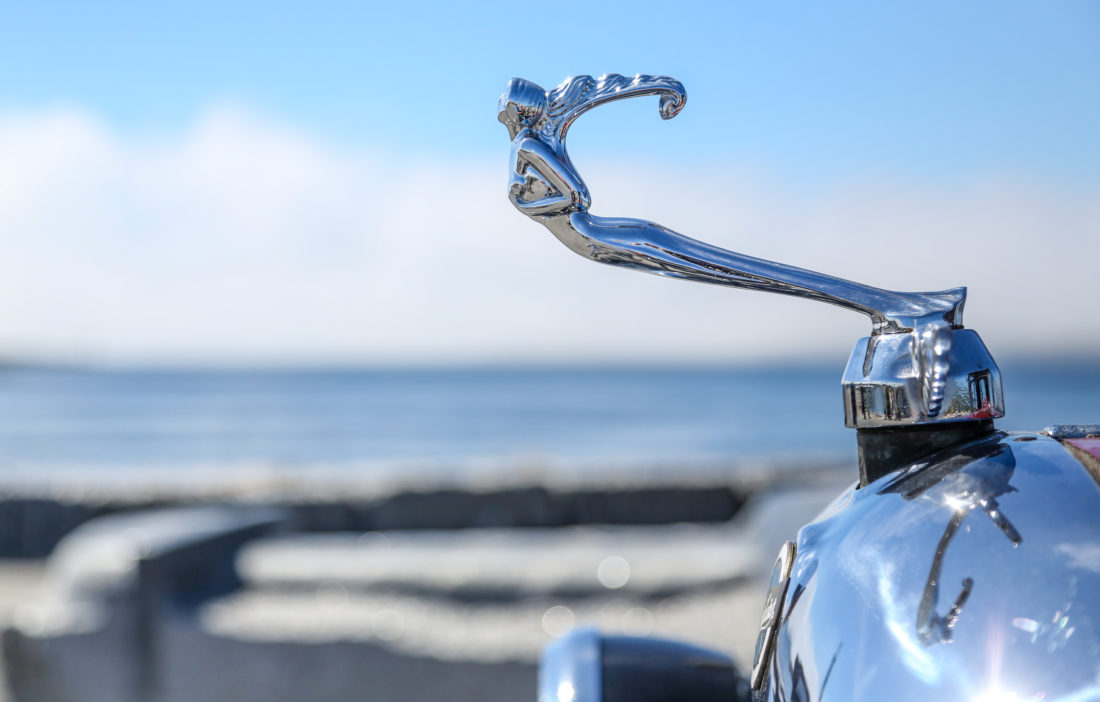
IT ALL STARTED WITH A T-FORD
“So, how did this enormous fascination with old cars emerge – and especially with American cars?”
“I have been interested in old cars since I was a young boy. Back in the old days they had a 1926 model T Ford here on the farm. It was so old that the Germans didn’t even bother to confiscate it during the war. My parents bought a new car after the war, but the T Ford was never sold, so it remained here in the farmyard. In the early 60s, there was an old ditch out on the field that had to be filled. In lack of other materials, the T-Ford ended up there. It probably still is down there somewhere. I have searched for it many times, without luck, but I haven’t given up”, Manvik tells us.
“So, my first veteran car was a 1926 model T Ford – exactly like the one we had on the farm. I bought it in Stockholm in 1998. I made it run, and it became very popular for weddings etc, with me as the chauffeur – always with a top hat and a cutaway.

MANVIK’s FAVORITE – PIERCE ARROW
Since then there has been many cars, but the common denominator is: They are all American.
“When you take a deep interest in American history, society and politics, it is only natural to go for a Pierce Arrow. It was, in fact, the official White House car, from President William Taft in 1909 until 1938, when the car factory went bankrupt. The unique thing about a Pierce, which I noticed watching old movies, it that the headlamps are integrated in the fenders, a patent they secured in 1913. It is therefore easy to spot a Pierce Arrow. I began looking for a car like that, and in 2012 I found one in Chicago. So I got on the first flight and bought it,” he eagerly explains.
“Then the snowball started rolling, you might say… Now I have four Pierce Arrows, which is quite unique in Europe. In Norway there are seven of them in total, and even fewer in Denmark and Sweden, and probably also in Germany. Globally, there may be around 2000 cars, and most of them are in the States, of course.
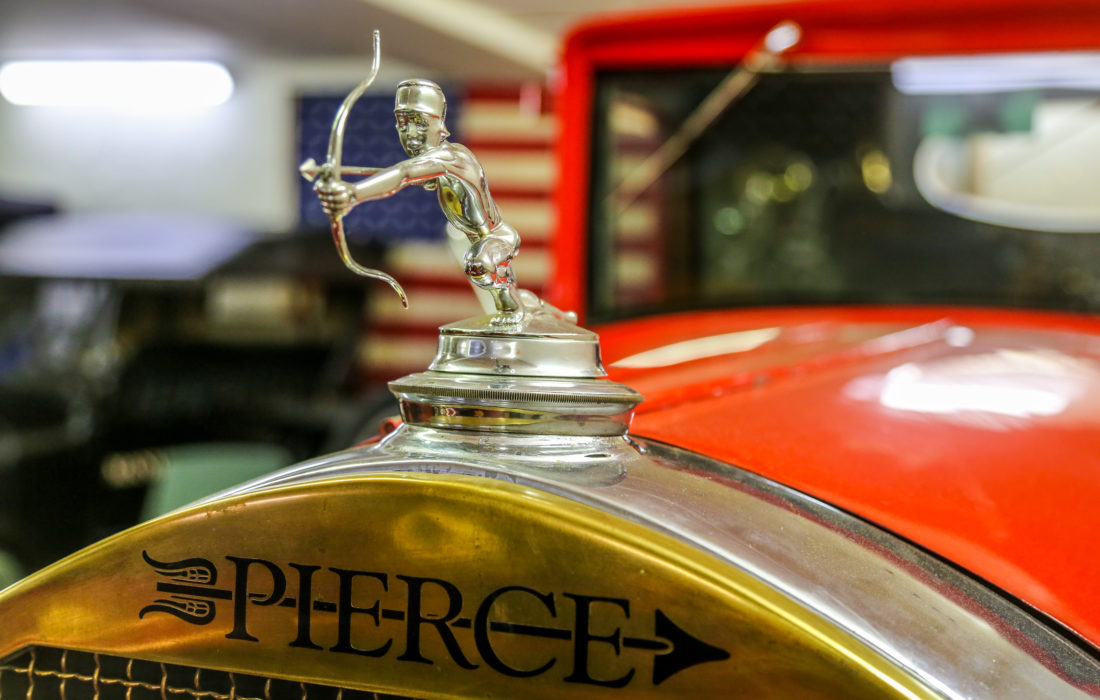
UNIQUE AHRENS-FOX HOOK-AND-LADDER TRUCK
When Manvik is asked which car in his collection is the most unique, there is no hesitation. It is his 36 feet long Ahrens Fox firetruck, or “The Rolls Royce of fire engines”, as it was originally advertised as.
“It showed up at a car auction on Oklahoma. I got it transported to Ft. Lauderdale, where I had to rent a 45 foot container in order to have it shipped to Norway. There was half an inch of clearing on all four sides,” he chuckles.
“As they were beginning to build taller building in New York and Chicago, they had to have bigger engines in order to power the stamp pads in these fire trucks. With an accumulator there was an enormous pressure. Finally, when the buildings were approaching 1000 feet, they had to give up fire fighting from the ground. Of the 23 motors that were made, 21 had pumps. So only two of them were hook-and-ladder trucks, like this one. One of them was running in New Jersey, and the other in Texas. The truck in New Jersey was later rebuilt, so this specimen is actually the only one left – in the whole world!
“The motor itself is unique. It has a volume of 18,5 litres, about 10 times that of a regular car. Not even modern trucks have that kind of engine power. Also, it has three plugs per cylinder. However, it turned out that both pistons and rods were removed before I bought it. The pistons are 6 inches in diameter and the rods are 22 inches long – enormous really. I have ordered new pistons and rods from a garage in the States, so soon I’ll be able to get it going. It will be quite a sight!”

THE INNER CIRCLE
The cars and parts Manvik is looking for, are usually quite hard to find, so he spends a lot of time on the Internet – at all hours.
“Well, yes, it does take time… I log on to check several sites every day. And of course, due to the time difference I have to check out auctions in the middle of the night. I often set my alarm clock to half past two when there is an auction happening at a quarter to three,” he says.
“If something really unique shows up, I’ll find an airline ticket to USA in a matter of hours. My first cars I bought in Denmark and Sweden; only in 2011 did I travel to the States to buy a car. I have since been there twice a year, usually in New Jersey, Florida and California, and I certainly visit the great Hershey-fair in Pennsylvania every fall. Norwegians are popular over there, and when I tell them about my four Pierce Arrows, I am immediately included in the inner circle,” Manvik smiles.

HARLEY DAVIDSON SCOOTERS
Manvik not only collects cars, he also exhibits other items in his potato cellar and barn.
“I recently started to collect historical American flags – preferably old samples. I have flags with 50, 48 and 13 stars, so now I only need the 7-star flag to be able to exhibit the confederate flag on my wall. I realize that it is not really acceptable to display the confederate flag anymore, but in such a historical context it should be OK,” he smiles. Manvik also has an impressive collection of 10 classic hood ornaments made of brass, neatly placed in a column in the potato cellar. Here we may also admire a collection of 8 old paintings of the New York – Paris car race, all of them painted by the same early 1900s painter.
Last, but not least, he has acquired two scooters from Harley Davidson.
“An American visitor had recently bought an entire Harley Davidson collection numbering 19 motorcycles, including four scooters. I had never heard of these scooter models before, and asked him if he would sell them. He wanted to keep one, so I bought the three others. A total of 3000 scooters were produced, and today probably only 1000 still exist,” he explains with great enthusiasm.

WHITE COATS
“When I went to the States to collect the scooters, I came across a copy of the Statue of Liberty, by sheer coincidence. I spotted it along the road near Jacksonville, Florida, and I pulled over and bought it, on impulse! We had to place it vertically, next to the three scooters on my pickup truck, and it must have been
quite a sight – there was a lot of honking and waving from meeting cars all along the way. A lot of fun,” Manvik laughs.
“I also found an old American fire hydrant over there, which I brought home. Everybody needs one of those, right? I plan to remove old paint and rust, sand it and paint it red. Then I will place it by the stone wall, next to the Statue of Liberty,” he says, obviously pleased.
Has this become somewhat of an obsession for you, Mr. Manvik?
“Well, yes, I suppose it has become quite an addiction, I must admit. But since I haven’t been approached by smooth-talking people in white coats, trying to medicate me, I guess it is all right,” he laughs.



